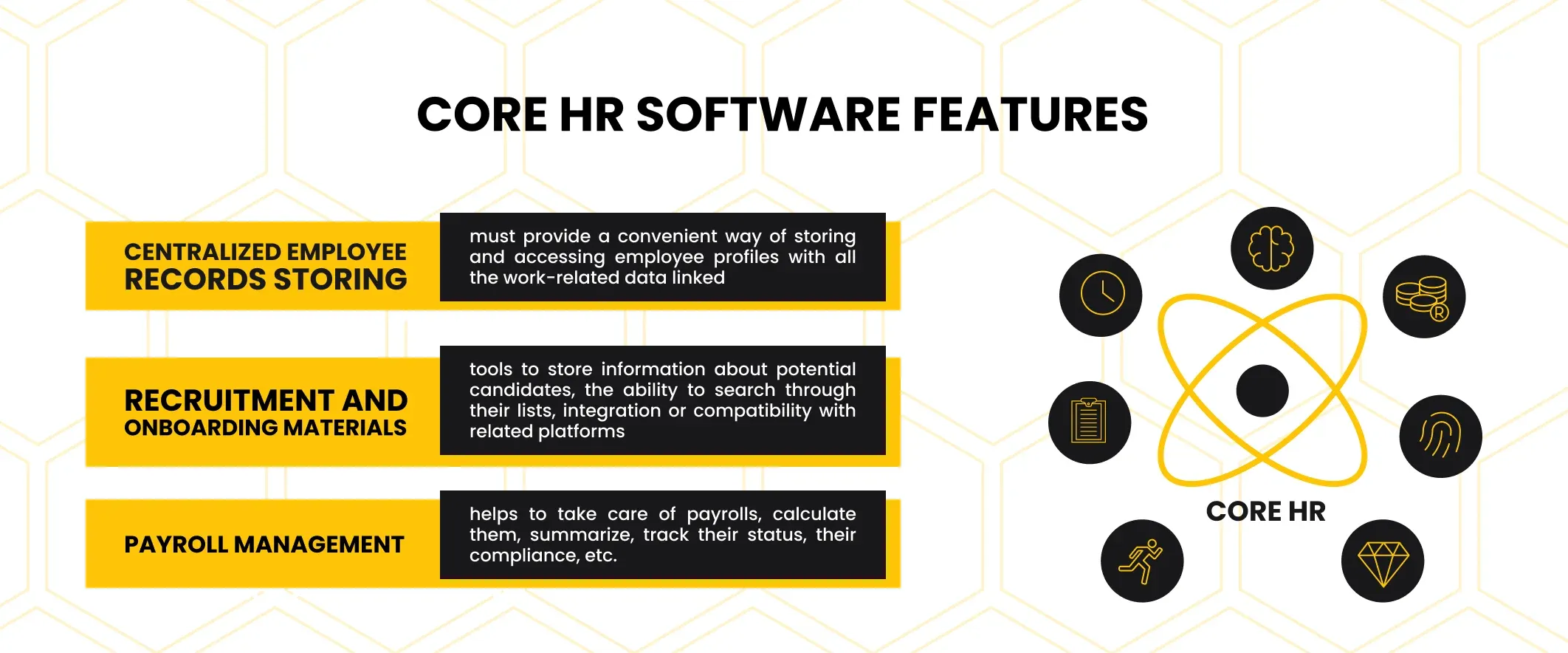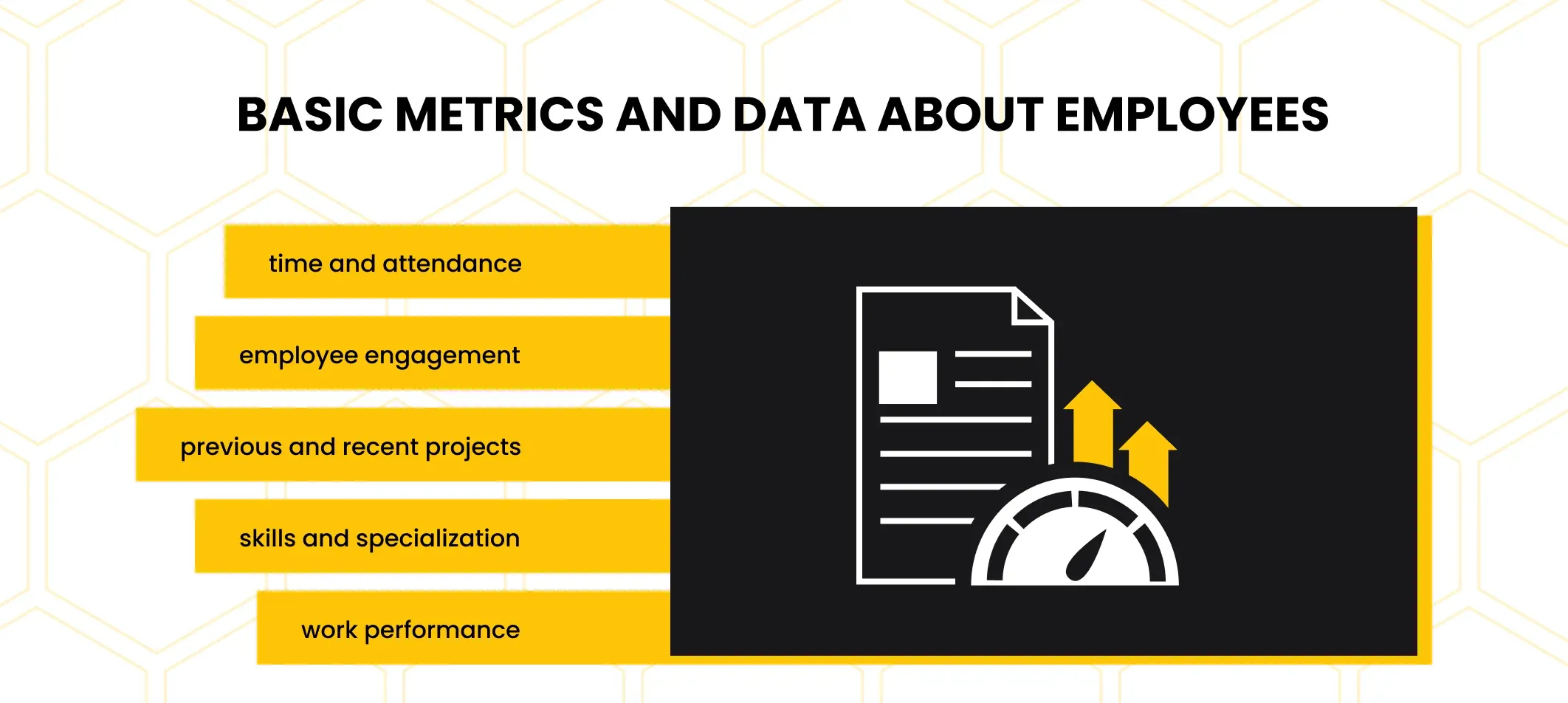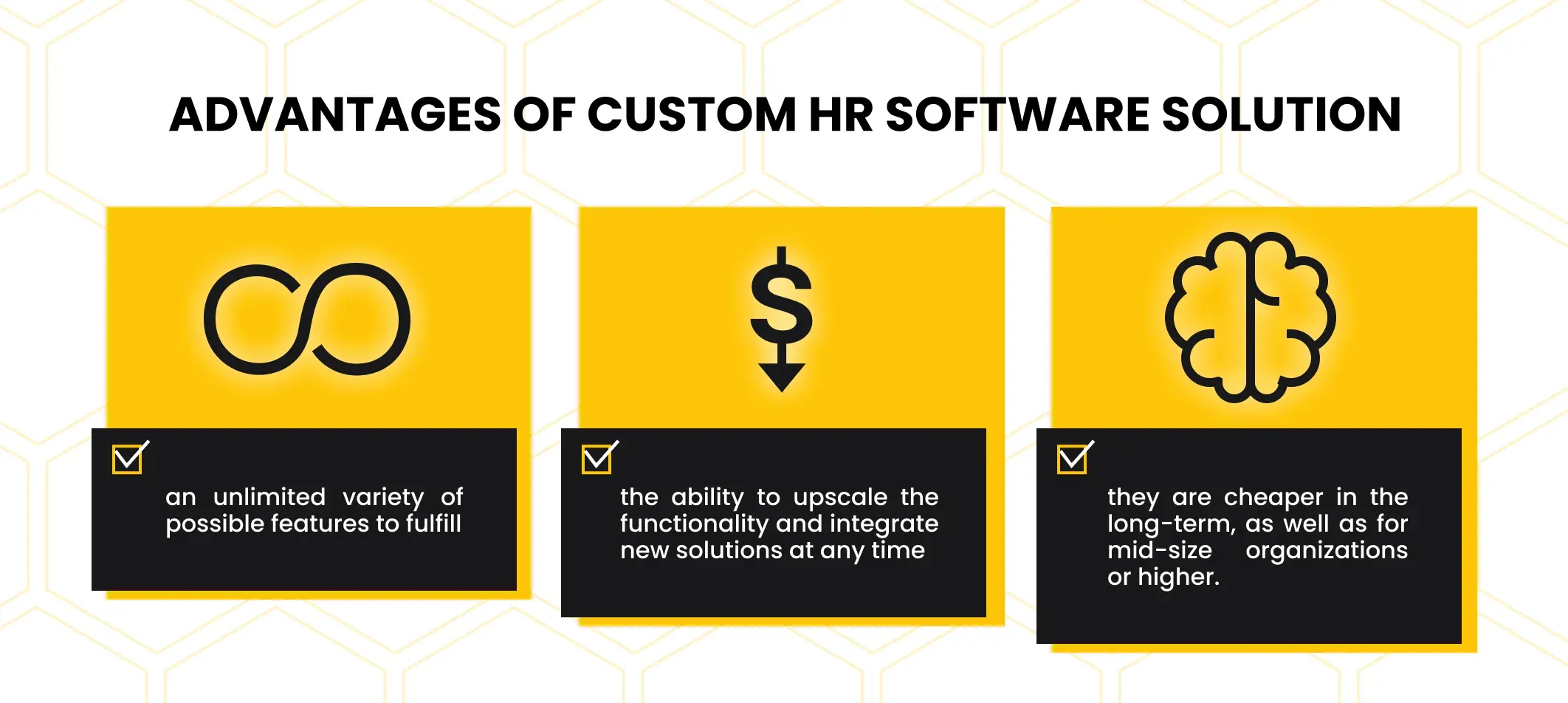Management Systems
Custom Human Resource Software: Key Features to Develop
November 02, 2023 • 235 Views • 17 min read
Tetiana Stoyko
CTO & Co-Founder
It is time to discuss the potential view of custom human resources software development outsourcing and the key features of HR automation software, worth considering.
To make it simple, it is impossible to imagine a single company, that works without the HR tools or other software, designed for project management and talent acquisition.
Such digital solutions greatly impact the overall efficiency and performance of any business, regardless of the industry it exists in. Therefore, it is essential to make the right choice when considering what exact HR or PM software you are willing to adopt as a business owner.
It may seem, that there is a wide range of different ready-made SaaS software development solutions, which have a lot of advantages, compared to any custom human resource software. For instance, they require no time or extra resources for development and can be easily integrated into any project just in a few clicks and for a relatively small fee.
Thus, let’s examine some of the ready-made software solutions for human resource management systems and compare them with a custom application for the same needs, in order to find out whether it is worth developing HR automation tools from scratch and what features are essential for the efficiency of such software.
What is HR Software?

As the name says, a human resource management system is an instrument, designed to simplify the working routine and repetitive tasks of human resource specialists by providing them with convenient software applications and other similar tools.
It can be either an all-in-one HR application with multiple features, or a variety of individual HR tools, that can be distributed as API or Plugins for existing human resource platforms.
Nevertheless, regardless of your preferences, there are basic HR software requirement specifications, which are true for any kind of these applications.
Obviously, HR systems feature the possibility to monitor the performance of your employees, and track their recent activities like the tasks they are working on at the moment, or that they have done lately. Yet, this is by far not the final list of key features of any human resource software.
Frankly, the functionality depends on your plans and accessible resources, as well as your expectations and HR software requirements. As with any other type of software application, the functionality of your custom HR system can be expanded in any direction you desire. Still, not all such extra features are essential for the efficiency of such software.
Hence, let’s narrow down the variety of components to the list of key features, needed for an HR system MVP. To rephrase it, let’s examine only the minimum number of the most essential functional options, the combination of which can be used for HR process management.
Human Resource Systems Key Features

User-Friendly Interface
Let’s start with the most obvious but essential aspects of any HR software.
It is important to take care of the user experience, regardless of your application's nature. However, HR systems are designed to be used on a routine basis. Additionally, most such apps propose numerous functional options and different types of information.
This is why it is very important to make the custom HR system as intuitive as possible. To do so, it is preferable to stick to different UI design patterns, which are predefined and already tested.
Clearly, you can make your adjustments, but if you are unsure of them - you always can use the experience of your competitors. This is especially true in cases when you lack experience in the design industry or don’t have enough niche-experienced app developers for hire.
Alternatively, you might also hire dedicated development team of designers, who are qualified and experienced sufficiently to implement all required elements.

Centralized Employee Records
Obviously, the ability to monitor different records and metrics of your employees is the core feature of any HR system.
This is why, it requires the most attention, compared to other functionality.
Probably, employee record storage is also one of the most customizable parts of HR systems. Different companies, project, and industries have their business requirements and preferences like important metrics to be displayed.
For some business owners employee working hours tracking is enough, for others the onboarding process might be much more sufficient. Besides, there are others, who want all the possible metrics and other types of information, related to their employees to conduct complex calculations and performance estimations. So, each HR system is somehow unique, when it comes to the stored and operated data.

The most basic metrics and data, usually accessible in HR software are:
- Time and attendance tracking
- Employee Engagement
- Previous and Recent Projects
- Skills and Specializations (optional, yet very common parameters, especially in large-scale companies),
- Work Performance
It is also recommended to make reports and recommendations reachable through the HR system, in order to maintain this information for further performance review and evaluation.
Most modern solutions for HR specialists also demand the ability to create a personal profile for each employee, in order to attach all the recorded data to a particular person and improve the overall navigation in the app.
Recruitment Management and Onboarding Procedures
Eventually, HR systems become an essential part of any recruitment process and employee onboarding activities.
They help to store and access information about the open position, potential specialists or candidates, etc.
To add some more, they can significantly simplify the employee onboarding process by providing candidates or HR department representatives with all required resources and links like user manuals, credentials, contacts with different departments, and so on.
To make it simple, the HR team can create depositories for each team, where they can store everything they need in a Notion-like app format.
Payments and Payroll Software
Additionally, one of the most trending features for any human resource management software nowadays is the payroll.
It is not always accompanied by different built-in FinTech solutions like an internal payment gateway or access to a corporate bank account through an app, which is a more advanced and less secure feature.
Still, the payroll management menu helps the HR team track the status of processed payments, monitor the salary progression, and make the salary calculation much easier.
Also, in case there are any corporate bonuses for workers to boost employee satisfaction, it is possible to make their progression trackable in the HR system.
Best Examples of HR Software SaaS
For a better illustration of how your future custom HR system may look and what HR tools you should consider before the HRM software development process, let’s consider some of the most popular examples of such technologies.
Clearly, such high-demand spheres as human resources can propose a wide range of best HR SaaS software, which have proven their success.
PeopleForce
PeopleForce is a complex HR toolkit.
Unlike the competitors, its owners decided not to limit themselves and instead of developing a single application, created an all-in-one HRM system.
Among the proposed features, there are:
- A centralized database of employee accounts with linked information on everything related to their profession.
- A similar platform, where potential candidates' profiles are stored.
- A few independent services for employee performance tracking, KPI evaluation, employee surveys, feedback gathering, and time tracking
- Built-in administrative tasks desk, which helps the HR team respond to employees' needs faster and more efficiently in a convenient and centralized way.
However, this HR SaaS is based on a subscription basis, and in order to use all the foregoing features, you will have to pay for each standalone solution an extra fee.
Sloneek
Similar to the previous example, Sloneek proposes a few services at once.
However, contrary to PeopleForce, this HR SaaS company provides more advanced core HR software as a basic version with the ability to integrate extended services. The main difference between these features and the ones, provided by competitors, is the fact, that basic functionality from Sloneek is mainly aimed at documentation and employee information management.
Additionally, all extra features are also divided by the industry and purposes: attendance and time tracking, performance management software, hiring process, onboarding, etc.
Calamari
At the same time, Calamari is a much smaller HR software provider, whose product seems to be rather an HR system MVP.
On the one hand, it proposes fewer features, compared to the alternatives. Mainly, these are core HR features with optional time management solutions.
However, it is also cheaper and can be a great illustration of how to deliver a smaller, yet as efficient HR SaaS.
Probably, it is possible to assume, that it is the best example of MVP from the list.
Advantages of Custom HR Solutions
So, if there are numerous examples of ready-made software for human capital management, why do you need to look for custom software instead of simply integrating one of the foregoing examples? Are there any major benefits, that a custom solution can bring to your cycle management?
Actually, there are at least a few of them.
Just like any other custom solution, developing a custom employee data management or any other similar system gives you, as a client, an unlimited number of possible outcomes.
Apart from having core HR functions, you can implement any idea, that comes to your mind. Still, at the same time, any choice for business owners will be accompanied by custom pricing, depending on the requirements they have.
We can spend the whole day here, talking about the additional features to design and develop in your custom human resource management software, and we won't ever name them all. Thus, instead, we would like to talk about one, yet the most advanced feature - the customization itself.
If you pay some attention to any of the foregoing examples of ready-made human resources management solutions, you will know, that despite the number of extra services, all of them are mainly limited to core HR features, so the only major difference between the basic and the most advanced version of any of these apps is the number of your business employees to add, i.e. the bigger your company is - the bigger the final price is.
While it seems not a big issue for small-scale companies, midsize businesses will already feel the difference, not to mention enterprise-level corporations.

So, the first advanced feature of custom solutions is the ability to embody any possible functionality you want.
The second benefit of creating your software is the ability to upscale it at any time and any scale needed, including the ability to create or integrate new services, which is not always possible, when it comes to SaaS HR tools.
And, finally, the third advantage of custom talent management apps is the fact, that they will be cheaper in long-term usage, and for mid-size organizations or higher.
Custom Human Resources Management with Incora
Eventually, judging from our experience, despite the variety of options to choose from, it is a common case, when business owners lack some features or are looking for more affordable software products for HR process management.
Additionally, many companies are considering the development of their own HR systems due to the fact, that it is much cheaper in the long term.
To cut a long story short, when it comes to purchasing such essential software for your product, it is better to count all the pros and cons. Also, it won’t be a bad idea to estimate how many resources will it take to order a custom HR SaaS with the possibility for future extensions if needed.
Fortunately, here at Incora, we have proven experience in developing different types of HR management solutions in terms of white label app development, which can be seen in our case studies. We also would be glad to answer all your questions. All you need to do - is sign the contact form and our team will get in touch with you for further explanation and clarification of details.
What’s your impression after reading this?
Love it!
1
Valuable
1
Exciting
1
Unsatisfied
1
FAQ
Let us address your doubts and clarify key points from the article for better understanding.
What is Custom Human Resource Software, and why is it essential for businesses?
Custom Human Resource Software is a specialized software solution designed to streamline HR processes within an organization. It offers tailor-made features that align with the specific needs of a company, making HR tasks more efficient, accurate, and convenient. This software can handle everything from recruitment and onboarding to employee management and payroll.
Can Custom HR Software integrate with other systems and tools?
Yes, Custom HR Software can be integrated with various third-party tools and systems. This includes integration with accounting software, time tracking systems, and even communication tools to create a more comprehensive HR ecosystem.
How long does it take to develop Custom HR Software?
The development timeline for Custom HR Software varies depending on its complexity and the specific features you require. Simple solutions may take a few months, while more complex projects can take a year or more. It's important to discuss your timeline with your development team.
What factors should I consider when choosing a development team for Custom HR Software?
When selecting a development team, consider factors such as their experience with HR software, their portfolio of past projects, their ability to understand your specific business needs, and their commitment to ongoing support and updates.
Is ongoing support and maintenance necessary for Custom HR Software?
Yes, ongoing support and maintenance are crucial to keep your Custom HR Software running smoothly. This includes fixing bugs, implementing updates, and providing technical assistance as needed. It ensures your software remains efficient and up to date.
Can I scale my Custom HR Software as my company grows?
Yes, Custom HR Software is designed to be scalable. You can expand its features and capabilities as your organization evolves, allowing it to adapt to changing HR requirements and a growing workforce.
What are the key features that should be developed in Custom HR Software?
Custom HR Software should be designed to meet your unique requirements, but some essential features to consider include:
- Employee Information Management: This feature allows you to store and manage all employee data, including personal and professional details, in a secure and organized manner.
- Recruitment and Applicant Tracking: Streamline your hiring process by tracking job applicants, managing job postings, and conducting interviews within the system.
- Onboarding and Training: Automate onboarding processes, including document management, training schedules, and compliance checks for new hires.
- Time and Attendance Management: Monitor employee work hours, attendance, and leave requests. This feature can also integrate with payroll.
- Performance Management: Enable performance appraisals, goal setting, and feedback collection for employees.
- Payroll and Benefits Administration: Process payroll, track benefits, and manage tax deductions for your workforce.
- Employee Self-Service: Provide employees with a portal to access their own data, request time off, and update personal information.
- Reporting and Analytics: Generate comprehensive reports on HR data, allowing data-driven decision-making.
- Compliance and Legal Tools: Ensure your HR software helps you comply with labor laws, regulations, and industry standards.
you may also like
Let’s talk!
This site uses cookies to improve your user experience. Read our Privacy Policy
Accept
Share this article